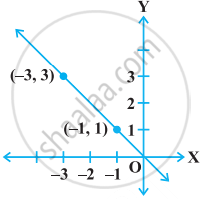Advertisements
Advertisements
प्रश्न
In countries like USA and Canada, temperature is measured in Fahrenheit, whereas in countries like India, it is measured in Celsius. Here is a linear equation that converts Fahrenheit to Celsius:-
`F=(9/5)C+32`
(i) Draw the graph of the linear equation above using Celsius for x-axis and Fahrenheit for y-axis.
(ii) If the temperature is 30°C, what is the temperature in Fahrenheit?
(iii) If the temperature is 95°F, what is the temperature in Celsius?
(iv) If the temperature is 0°C, what is the temperature in Fahrenheit and if the temperature is 0°F, what is the temperature in Celsius?
(v) Is there a temperature which is numerically the same in both Fahrenheit and Celsius? If yes, find it.
उत्तर
(i) `F=(9/5)C+32`
It can be observed that points (0, 32) and (−40, −40) satisfy the given equation. Therefore, these points are the solutions of this equation.
The graph of the above equation is constructed as follows.

(ii) Temperature = 30°C
`F=(9/5)C+32`
`F=(9/5)30+32 = 54+32=86`
Therefore, the temperature in Fahrenheit is 86°F.
(iii) Temperature = 95°F
`F=(9/5)C+32`
`95=(9/5)C+32`
`63=(9/5)C`
C = 35
Therefore, the temperature in Celsius is 35°C.
(iv) `F=(9/5)C+32`
If C = 0°C, then
`F=(9/5)0+32`
Therefore, if C = 0°C, then F = 32°F
If F = 0°F, then
`0=(9/5)C+32`
`(9/5)C=-32`
`C=-160/9=-17.77`
Therefore, if F = 0°F, then C = −17.8°C
(v) `F=(9/5)C+32`
Here, F = C
`F=(9/5)F+32`
`(9/5-1)F+32=0`
`(4/5)F=-32`
F = -40
Yes, there is a temperature, −40°, which is numerically the same in both Fahrenheit and Celsius.
APPEARS IN
संबंधित प्रश्न
Draw the graph for the equation, given below :
2x + 3y = 0
Solve, graphically, the following pairs of equations :
`(x + 1)/(4) = (2)/(3)(1 - 2y)`
`(2 + 5y)/(3) = x/(7) -2`
Use graph paper for this question. Take 2 cm = 1 unit on both the axes.
- Draw the graphs of x + y + 3 = 0 and 3x - 2y + 4 = 0. Plot only three points per line.
- Write down the coordinates of the point of intersection of the lines.
- Measure and record the distance of the point of intersection of the lines from the origin in cm.
Using a scale of 1 cm to 1 unit for both the axes, draw the graphs of the following equations: 6y = 5x + 10, y = 5x - 15.
From the graph find :
(i) the coordinates of the point where the two lines intersect;
(ii) the area of the triangle between the lines and the x-axis.
A pair of linear equations has no solution then the graphical representation is
Draw the graph of y = – 3x
The graph of the linear equation x + 2y = 7 passes through the point (0, 7).
The graph given below represents the linear equation x + y = 0.

Draw the graph of the linear equation whose solutions are represented by the points having the sum of the coordinates as 10 units.
The force exerted to pull a cart is directly proportional to the acceleration produced in the body. Express the statement as a linear equation of two variables and draw the graph of the same by taking the constant mass equal to 6 kg. Read from the graph, the force required when the acceleration produced is (i) 5 m/sec2, (ii) 6 m/sec2.
